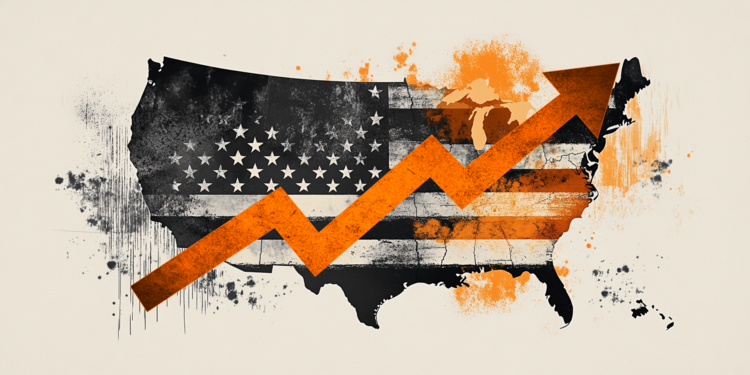Here is what you need to know on Friday, February 28:
The US Dollar (USD) Index, which tracks the USD’s performance against a basket of six major currencies, clings to small daily gains after touching a two-week-high near 107.50 early Friday. Investors await preliminary February Consumer Price Index data from Germany January the Personal Consumption Expenditures (PCE) Price Index data, the Federal Reserve’s (Fed) preferred gauge of inflation, from the US. Additionally, Statistics Canada will publish Gross Domestic Product (GDP) growth for the fourth quarter.
US Dollar PRICE This week
The table below shows the percentage change of US Dollar (USD) against listed major currencies this week. US Dollar was the strongest against the New Zealand Dollar.
| USD | EUR | GBP | JPY | CAD | AUD | NZD | CHF | |
|---|---|---|---|---|---|---|---|---|
| USD | 0.73% | 0.39% | 0.60% | 1.60% | 2.34% | 2.55% | 0.39% | |
| EUR | -0.73% | -0.42% | -0.31% | 0.68% | 1.59% | 1.62% | -0.50% | |
| GBP | -0.39% | 0.42% | 0.17% | 1.11% | 2.02% | 2.05% | -0.08% | |
| JPY | -0.60% | 0.31% | -0.17% | 1.00% | 1.82% | 2.03% | -0.11% | |
| CAD | -1.60% | -0.68% | -1.11% | -1.00% | 0.68% | 0.93% | -1.17% | |
| AUD | -2.34% | -1.59% | -2.02% | -1.82% | -0.68% | 0.03% | -2.06% | |
| NZD | -2.55% | -1.62% | -2.05% | -2.03% | -0.93% | -0.03% | -2.09% | |
| CHF | -0.39% | 0.50% | 0.08% | 0.11% | 1.17% | 2.06% | 2.09% |
The heat map shows percentage changes of major currencies against each other. The base currency is picked from the left column, while the quote currency is picked from the top row. For example, if you pick the US Dollar from the left column and move along the horizontal line to the Japanese Yen, the percentage change displayed in the box will represent USD (base)/JPY (quote).
The USD gathered strength against its rivals in the second half of the day on Thursday after US President Donald Trump that the planned 25% tariff package on Mexican and Canadian imports will come into effect on March 4 as planned, rather than April 2nd that he mentioned a day earlier. On that date, China will also be charged an extra 10% tariff. Safe-haven flows dominated the action in financial markets following these comments and Wall Street’s main indexes suffered large losses, helping the USD find demand.
In the early trading hours of the Asian session, the data from Japan showed that the Tokyo Consumer Price Index rose by 2.9% on a yearly basis in February, down from the 3.4% increase recorded in January. Meanwhile, Bank of Japan Deputy Governor Shinichi Uchida noted that the economy was experiencing a moderate recovery, with some weaknesses persisting. After rising nearly 0.5% on Thursday, USD/JPY trades marginally higher on the day near 150.00 in the European morning on Friday.
EUR/USD came under heavy bearish pressure and lost about 0.8% on Thursday. The pair struggles to find a foothold early Friday and trades below 1.0400. The data from Germany showed that Retail Sales rose 0.2% in January, following the 1.6% decrease recorded in December, but failed to help the Euro gather strength.
GBP/USD turned south late Thursday and lost more than 0.5% on the day. The pair continues to stretch lower early Friday and trades below 1.2600.
Gold extended its correction on Thursday and lost about 1.3%. XAU/USD stays under bearish pressure early Friday and trades at its weakest level in three weeks near $2,860.
AUD/USD fell more than 1% on Thursday and closed the fifth consecutive day in negative territory. The pair continues to stretch lower on Friday and trades at its lowest level since early February at around 0.6200.
Tariffs FAQs
Tariffs are customs duties levied on certain merchandise imports or a category of products. Tariffs are designed to help local producers and manufacturers be more competitive in the market by providing a price advantage over similar goods that can be imported. Tariffs are widely used as tools of protectionism, along with trade barriers and import quotas.
Although tariffs and taxes both generate government revenue to fund public goods and services, they have several distinctions. Tariffs are prepaid at the port of entry, while taxes are paid at the time of purchase. Taxes are imposed on individual taxpayers and businesses, while tariffs are paid by importers.
There are two schools of thought among economists regarding the usage of tariffs. While some argue that tariffs are necessary to protect domestic industries and address trade imbalances, others see them as a harmful tool that could potentially drive prices higher over the long term and lead to a damaging trade war by encouraging tit-for-tat tariffs.
During the run-up to the presidential election in November 2024, Donald Trump made it clear that he intends to use tariffs to support the US economy and American producers. In 2024, Mexico, China and Canada accounted for 42% of total US imports. In this period, Mexico stood out as the top exporter with $466.6 billion, according to the US Census Bureau. Hence, Trump wants to focus on these three nations when imposing tariffs. He also plans to use the revenue generated through tariffs to lower personal income taxes.
Read the full article here


